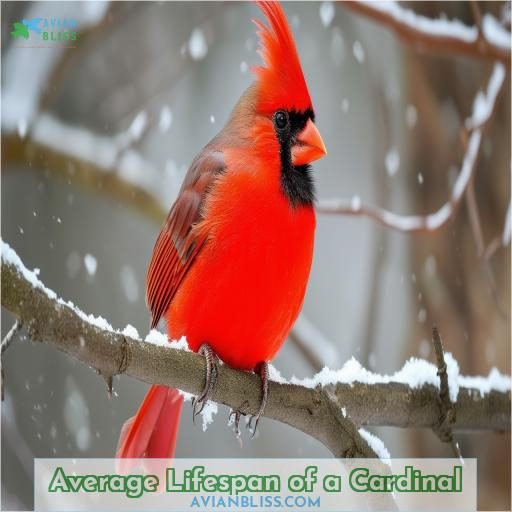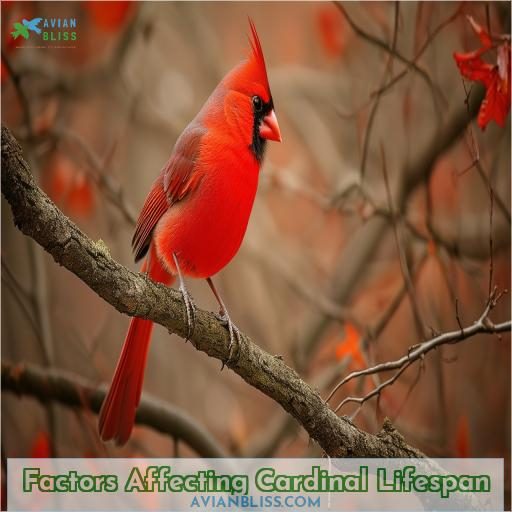This site is supported by our readers. We may earn a commission, at no cost to you, if you purchase through links.

However, in the wild, their average lifespan is around 3 years, with some lucky ones making it to 15.
With proper care in captivity, Cardinals can live up to 15 thriving years.
Factors like predation, collisions, harsh weather, and food scarcity play a major role in determining their longevity in nature.
By providing food, shelter, and safeguarding against window strikes, you can help your feathered friends live longer, more colorful lives.
Want to uncover the secrets to their vibrant existence?
Table Of Contents
- Key Takeaways
- How Long Do Cardinals Live?
- Average Lifespan of a Cardinal
- Factors Affecting Cardinal Lifespan
- Helping Cardinals Live Longer
- Frequently Asked Questions (FAQs)
- Do cardinals come back to the same place every year?
- Do cardinals recognize humans?
- Do red cardinals mate for life?
- What is the lifespan of a cardinal?
- How can nest predators affect cardinal lifespan?
- Do cardinals live longer in urban areas?
- How does weather impact cardinal longevity?
- Are there diseases that shorten cardinal lives?
- What role does diet play in lifespan?
- Conclusion
Key Takeaways
- These vibrant backyard beauties are true survivalists! Cardinals living in the wild have an average lifespan of 3 years, but some lucky feathered friends can make it to the ripe old age of 15. Talk about endurance!
- While the great outdoors is undoubtedly exhilarating for our scarlet songbirds, captivity comes with its perks. With a cushy home, gourmet buffet, and top-notch healthcare, cardinals in captivity can live up to 15 thriving years. It’s the avian equivalent of a luxury resort!
- Alas, the journey to longevity is fraught with obstacles for these feisty featherballs. From hungry hawks and sneaky snakes to the perils of window strikes and harsh weather, our crimson comrades face no shortage of challenges in the wild.
- But fear not, dear bird enthusiasts! By rolling out the red carpet with ample food, shelter, and a vigilant eye against potential hazards, you can become a guardian angel for your local cardinal clan, ensuring their vibrant presence graces your backyard for seasons to come.
How Long Do Cardinals Live?
How long do cardinals live? In the wild, the average lifespan of a cardinal is 3 to 5 years, but in captivity, they can live up to 15 years with proper care.
Average Lifespan of a Cardinal
The average lifespan of a northern cardinal (Cardinalis cardinalis) varies depending on whether the bird lives in the wild or in captivity. In the wild, these iconic songbirds typically survive 3 years on average, with some hardy individuals reaching the maximum recorded lifespan of 15 years.
In the Wild
You’ll often spot cardinals’ vibrant feathers amid dense thickets, where they:
- Build well-concealed nests
- Forage for seeds and insects
- Sing their distinctive territorial songs
In the wild, these nonmigratory birds typically live 3-5 years, balancing breeding demands with eluding predators and finding adequate food sources.
In Captivity
In captivity, cardinals can remarkably live up to 15 years with proper care. Key factors contributing to their longevity include:
- Balanced diet and access to clean water
- Spacious, enriched enclosures mimicking their natural habitat
- Preventive veterinary care and prompt treatment of illnesses
Providing an optimal captive environment allows these vibrant birds to thrive and reach their maximum lifespan potential.
Factors Affecting Cardinal Lifespan
Cardinals face numerous threats that can shorten their lifespan, from the ever-present danger of predators like hawks, cats, and snakes to the hazards posed by human activity, such as collisions with windows and vehicles. Harsh weather conditions, especially during breeding season when food sources may be scarce, can also take a toll on these vibrant backyard birds.
Predation
You’re right to be concerned about predation – cardinals face significant threats from:
- Hawks and owls preying on adults
- Snakes raiding nests for eggs and chicks
- Outdoor cats hunting vulnerable fledglings
Ground-foraging makes cardinals especially susceptible. Ensuring proper nesting cover and being a responsible pet owner can boost their breeding success and survival rates.
Collisions
Window collisions pose a major risk for cardinals’ longevity. Their vibrant plumage and territorial nature make them prone to striking reflective surfaces. To protect these "visitors from heaven," consider:
- Applying anti-collision decals
- Using external window screens
- Closing curtains
- Landscaping strategically
- Advocating for bird-safe architecture
Harsh Weather
Extreme weather poses another threat – frigid winters and scorching summers can quickly turn deadly. You can help cardinals survive by:
- Providing sheltered areas for protection from wind, rain, and snow
- Ensuring a reliable water source to prevent dehydration
- Offering high-calorie foods at feeders to maintain energy reserves
With some simple accommodations, your backyard oasis becomes a lifeline when nature turns harsh.
Lack of Food
Lack of food can severely impact cardinal lifespan. When winters are harsh or food sources scarce, cardinals struggle to find:
- Nutrient-rich seeds
- Berries and fruits
- Insects for protein
You can help by providing a consistent supply of high-quality bird feed, suet, and maintaining natural vegetation for foraging.
Helping Cardinals Live Longer
You can help cardinals live longer by providing a consistent supply of high-quality food sources like sunflower seeds, fruit, and suet.
Creating a safe habitat with dense shrubs and vegetation for nesting and protection from predators is also beneficial.
Additionally, take steps to prevent window strikes, which can be fatal.
Use decals or other deterrents on glass surfaces.
Support conservation efforts that protect cardinal populations and their natural habitats.
Provide Food
One way to help cardinals live longer is by providing them with a variety of foods. Here are four tips:
- Offer high-quality seed mixes with sunflower, safflower, and nyjer.
- Supplement with fresh fruits like oranges, grapes, and berries.
- Include suet cakes or peanut butter for protein.
- Make sure a clean water source is available.
Create Habitat
You can also help cardinals by creating the perfect backyard habitat. They thrive in areas with:
- Dense shrubs for nesting
- Understory plants for foraging
- Trees for singing perches
Providing native plants nurtures their favorite foods, like insects and berries. And don’t forget a heated birdbath for winter survival!
Prevent Window Strikes
One effective way to help cardinals live longer is to prevent window strikes. You can take these steps:
- Use decals or window screens to make glass visible
- Close curtains at night to reduce indoor light reflection
- Grow dense shrubs near windows to discourage collisions
- Support local Audubon chapters that promote safe practices
Support Conservation
Along with providing food and creating a safe haven, you can support conservation organizations that protect cardinals and their habitats. Get involved in:
- Habitat restoration projects
- Citizen science initiatives
- Community outreach programs
- Urban wildlife advocacy groups
Frequently Asked Questions (FAQs)
Do cardinals come back to the same place every year?
Yes, cardinals are non-migratory birds that tend to return to the same area year after year. Their strong homing instinct means you’ll likely see the same feathered friends visiting your backyard annually.
Do cardinals recognize humans?
Yes, cardinals can recognize human faces and voices. They’re intelligent birds that form strong bonds with people who feed them regularly. With time and patience, you can develop a delightful relationship with your backyard cardinals.
Do red cardinals mate for life?
Yes, cardinals typically mate for life. These resilient birds form strong pair bonds, often remaining together for several breeding seasons until one partner dies.
What is the lifespan of a cardinal?
Cardinals have an average lifespan of 3 years in the wild, though they can live up to 15 years with proper care. These resilient songbirds bring vibrant color and joy to gardens across North America.
How can nest predators affect cardinal lifespan?
Nest predators like snakes, hawks, raccoons can greatly reduce a cardinal’s lifespan – as few as 30% survive their first year! Providing nest boxes and deterring predators protects these beautiful backyard birds.
Do cardinals live longer in urban areas?
Yes, cardinals tend to live longer in urban areas due to abundant food sources from backyard feeders and lack of natural predators.
How does weather impact cardinal longevity?
You won’t believe how weather impacts cardinal longevity! Severe winters take a toll, reducing their lifespan, while mild conditions allow them to thrive for over a decade. Stay tuned to learn more about these resilient songbirds.
Are there diseases that shorten cardinal lives?
Yes, cardinals can fall victim to diseases like salmonella, trichomoniasis, and avian pox, potentially shortening their lifespan. Proper feeder maintenance and avoiding overcrowding can reduce disease transmission.
What role does diet play in lifespan?
Consuming a nutritious diet rich in seeds, fruits, and insects guarantees cardinals maintain excellent health, minimizing risks and extending their lifespan.
Conclusion
By channeling your inner Johnny Appleseed, you can foster an environment where cardinals flourish, answering the age-old question: how long do cardinals live? Providing ample food, shelter, and protection allows these bright birds to reach their maximum thriving lifespan of 15 years. With dedication, you’ll enjoy their radiant presence for seasons to come.






